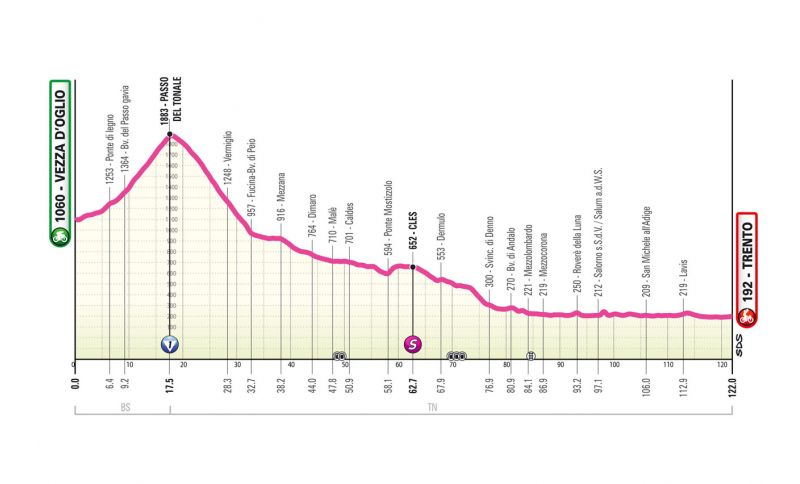

On the official roadbook, the Vezza d'Oglio-Trento (122 kilometers to cover) is classified as a stage for fast wheels, but it could be a truly unpredictable day.
to follow the live coverage of the entire stage starting at 11:20 CLICK HERE
Right from the start, riders will face the Tonale Pass, a first-category climb that risks taking pure sprinters out of contention: 11 km of climbing with a 5.6% average gradient leading to the Cima Alfonsina Strada of the race, and some teams might seize the opportunity to eliminate their most dangerous rivals. From the Tonale Pass summit, over 100 km remain with a very long descent through Val di Sole and Val di Non. After Mezzolombardo, the race continues through vineyards with gentle undulations until crossing the Adige River, heading towards Trento's finish line: will we truly witness the first sprint of this edition?
THE TERRITORY. On the third day of the race, the Giro Women bids farewell to Lombardy, departing with one of its most beautiful alpine views. Alta Valle Camonica is located between Stelvio National Park and Adamello Park, a double guarantee of great beauty and environmental respect. The start from Vezza d'Oglio inspires lovers of high-altitude landscapes who can look towards the peaks of Val Paghera and the high-altitude pastures of Val Grande, known for its large deer population. From Vezza passes the Oglio cycle path that follows the Oglio river to its source at Tonale Pass and which, in 2019, was awarded the Italian Green Road Award as the "most beautiful cycle path in Italy".
The race route naturally winds along the state road, crossing Temù and Ponte di Legno before tackling the comfortable turns leading to Tonale Pass. The wide pass leads to the border with Trentino, which presents itself to the athletes with its gentlest face. From here to the finish, riders will pedal almost exclusively downhill, traversing the entire Val di Sole. After crossing Vermiglio, the village made famous by the film of the same name nominated for an Oscar in 2025, they will enter the valley carved by the Noce River's waters, a destination for rafting and kayaking enthusiasts from around the world.
All around, villages, castles, and monuments to work characterize Val di Sole. The structures of Castel Caldes and Ossana Castle certainly do not go unnoticed, but then one is pleasantly surprised by the artistic sundials painted on the walls of Pession and Monclassico villages: there are more than 50, all different from a technical and artistic perspective, all daughters of a project started in 2002 to enhance the ancient local tradition. The various small museums dedicated to traditional work, like the Venetian sawmills of Malè, Dimaro, and Ortisè, tell stories of ancient toil (and skill).
Cles, surrounded by apple orchards that have recently brought fortune to Val di Non, stands out for the elegant buildings of its historic center developing around the Assumption Pieve, today in Gothic-Renaissance style but already mentioned in a document from 1188. Not to be missed here is also the Church of San Vigilio (12th century), notable for the importance of its 14th and 15th-century frescoes considered among the most interesting of Trentino Gothic.
Before reaching the finish line, one crosses the Rotaliana Plain with its hills covered in vineyards, producing some of the best wines in the Trento province: first among them Trento DOC, the sparkling wine symbol of excellence, and Teroldego Rotaliano DOC, considered the prince of Trentino red wines.
In such a context, it is pleasant to reach Trento, which welcomes with the magnificence of the San Vigilio Cathedral and the frescoed facades of 16th-century palaces, with the artworks preserved in the Buonconsiglio Castle and the recent MUSE - Science Museum designed by Renzo Piano.

Se sei giá nostro utente esegui il login altrimenti registrati.